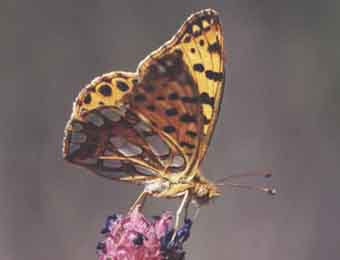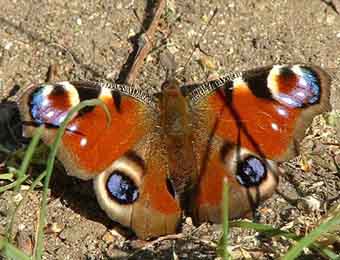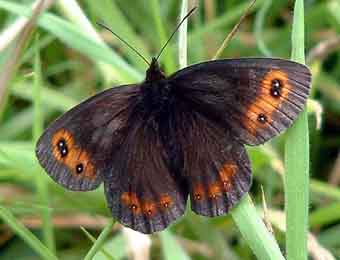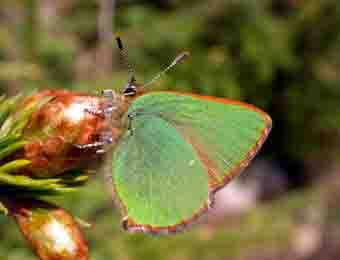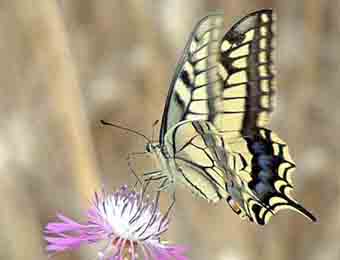|

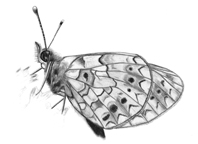
Ayrshire
Butterfly Report 1998
F
S Simpson
Introduction
Following a series of excellent seasons for butterflies in Ayrshire, 1998 provided mixed fortunes for the 25 species recorded between February
and November. After a good spring, the summer was extremely unsettled with June and July together being the wettest on record since 1938!
Although temperatures were around the average, the lack of sunshine meant that species emerging in these two months generally did so on a
smaller scale and this no doubt affected their breeding successes. Additionaly, the number of observers contributing reports was down on
previous years and therefore this report is an approximate summary rather than a definite statement on Ayrshire butterflies in 1998.
The season opened exceptionally early with a Small Tortoiseshell in Cumnock on February 21st. Since conditions were very favourable at this
time, it can be assumed that this record relates to a genuine emergence rather than an individual disturbed from hibernation. More Tortoiseshells
emerged in March with Peacock appearing on the 31st. April saw the emergence of a further four species with Small White again putting in an
early appearance on the 18th. Excellent conditions in May produced good numbers of Green Hairstreak and Orange Tip and Wall Brown appeared
very early with four on the 16th. Small Copper and Large White also made early appearances in May and Painted Ladies were found before the
months end. An unsettled summer followed, with Fritillaries and other scarcer species performing poorly. However, the highlight of the butterfly
year was the arrival of that colourful migrant, the Clouded Yellow - the first wave of migrants appearing in late June. 1998 also produced the
first June sighting of Dingy Skipper since the report began. July had little to commend it and many species did not peak until August. Common
Blue, Grayling, Meadow Brown and Small Heath occurred in reasonably good numbers but Scotch Argus, Large Heath and Ringlet fared badly.
Although too late for many species, prospects improved in September with good numbers of Small and Large Whites, Peacocks and Red Admirals.
The Ayrshire coastline proved rewarding for migrants late month, with Painted Ladies and the second wave of Clouded Yellows. Nine species
remained on the wing into early October and the season closed with a single Red Admiral at Auchincruive on the 6th.
As this report was being completed, an astonished observer found a female Small White flying in fine weather at Auchincruive on March 26th.
The butterfly was approximately 75% normal size and was observed again on the 30th.
The
Top Ten
This chart is based on the total number of different Ordnance Survey 1km squares for which records were received for each species. Ayrshire's
'Top Ten' butterflies of 1998 are listed below, with the previous year positions for comparison.
1998 |
1997 |
Species |
1. |
1. |
Green-veined White |
2. |
2. |
Small Tortoiseshell |
3. |
5. |
Red Admiral |
4. |
3. |
Meadow Brown |
5. |
- |
Large White |
6. |
4. |
Small White |
7. |
10. |
Orange-tip |
8. |
9. |
Peacock |
9. |
7. |
Small Heath |
10. |
6. |
Small Copper |
Systematic
List
Large Skipper Oclodes venata
STATUS: Locally common resident in southern Ayrshire - possibly expanding northwards.
FLIGHT PERIOD: June-July. Single generation.
The Large Skipper had a rather poor year in terms of reports, although its season was probably affected by the poor weather during June and
July. The first five were noted at a coastal site south of Lendalfoot on June 12th. Top counts were of 11 at the above mentioned site on June
27th and 10 at Feoch Meadows SWT Reserve on July 11th, where a mating pair were observed. An interesting discovery was made on July 2nd
when a single was observed on Mochrum Hill. This record constitutes the most northerly colony known in Ayrshire and is in a new 10km O.S.
square for the species. The last was noted nectaring at a site north of Lendalfoot on August 1st.
Dingy Skipper Erynnis tages
STATUS: Very rare resident - appears to be exclusively coastal.
FLIGHT PERIOD: Uncertain, but a period within May-Jun. Single generation.
Ayrshire's rarest species continues to be detected with another individual found in 1998 by one diligent observer on June 12th at a site south of
Lendalfoot. This is the same location where the butterfly was reported from in 1993. The exact flight period of the Dingy Skipper in the county
has yet to be determined but this record, some two weeks later than previous sightings, helps in establishing this.
Clouded Yellow Colias croceus
STATUS: Rare migrant.
FLIGHT PERIOD: Appears Jun-Oct in two generations.
For the first time since 1992, Ayrshire experienced a 'Clouded Yellow Year' with 31 reports of 73 individuals. The influx occurred in two waves
with several reported in late June followed by greater numbers during the 'Indian Summer' of late September. The species was first reported on
June 20th with one at Bennane Head, followed by singles on June 27th at Turnberry GC and at a site north of Lendalfoot. The last report of the
first generation concerned one in Prestwick's Main Street on July 1st. The second wave of migrants was first noted on September 18th with one
at Maidens, quickly followed by sightings at the following locations until the 29th: Turnberry, Monkton, Ballantrae, Portencross, Hunterston,
Dipple, Balkenna, Lendalfoot, Troon, Springside, Garnock Floods, Knockshinnoch Lagoons, Fairlie, Dunure, Bracken Bay, Finnarts Bay and
Stevenston Point. The butterfly was found mainly along the coastline as the distribution map illustrates. The exceptions to this were one on
September 21st on the disused railwayline at Springside and one on September 23rd at Knockshinnoch Lagoons. Notable counts were as follows:
seven at Turnberry on the 20th; 12 at Dipple on the 21st and eight at Turnberry Point on the 26th. Three records were received for October, all
at Turnberry Point, with one on the 2nd, four on the 4th and finally three on the 8th. The Turnberry records suggest that this site supported a
resident population at this time. One observer who reported 38 individuals found only two of these to be female - one of which was of the
helice form and was observed at Dipple on September 21st. This is a colour variant occurring in females in which the ground colour of the wings
is replaced by pale creamy white with dark brown marginal borders. This colour variation is produced by a single gene and is expressed in 5-15%
of females1.
The following table provides a breakdown of monthly numbers.
Month |
Reports |
Individuals |
June |
3 |
3 |
July |
1 |
1 |
August |
0 |
0 |
September |
24 |
61 |
October |
3 |
8 |
Large White Pieris brassicae
STATUS: Fairly common resident and migrant - abundant in some years.
FLIGHT PERIOD: Late May-early Oct in two generations
The Large White fared better in 1998 than in the previous two years despite the poor summer weather. As with last year, May produced several
early records with two at Corsehouse Reservoir on the 16th followed by three at Mochrum Hill and three at Auchincruive on the 18th. First
generation numbers were typically low but was reported as 'common' from Prestwick and Ayr in early June. First reports of second generation
individuals were later than average with one at Northcraig Reservoir on July 26th and one at Gailes on August 2nd. Numbers began to build in
early August. Notable counts were as follows: 13, Knockentiber - Springside disused railwayline on August 9th; an excellent 100 between Dipple
and Balkenna on August 10th; 35 between Girvan and Lendalfoot on September 5th and 23 still present at Dipple on September 9th. The species
was widely reported until the end of September with October producing two reports concerning three at Turnberry on the 2nd and one on the
3rd.
Small White Pieris rapae
STATUS: Common resident and migrant - abundant in some years.
FLIGHT PERIOD: Late Apr- early to mid Oct in two generations.
The Small White continued its run of good seasons in 1998 and typically, populations were at their peak in the month of August. As with last
year, the butterfly put in an early appearance with singles on the disused railwayline at Knockentiber April 18th and 23rd, followed by three at
Auchincruive and one at Prestwick on the 27th. The main emergence was noted from the beginning of May, but as is usual for this species, the
first generation occurred in low numbers. Maximum counts involved 12 at Auchincruive on May 26th and 19 between Knockentiber and Springside
on June 14th. Second generation numbers began to build in late July with 10 at Balkenna on 23rd. Thereafter, good numbers were noted as
follows with a bias towards coastal areas: 63 along the disused railwayline between Knockentiber and Springside on August 9th; 40 between
Dipple and Balkenna on the 10th; 15 at Ballantrae on the 10th; 22 at Balkenna and 100+ between Girvan and Lendalfoot on September 5th.
Numbers decreased in late September although 12 were counted at Turnberry Point on the 26th. Singles were noted in the first week of October
with the latest at Maidens on the 8th and Auchincruive on the 9th.
Green-veined White Pieris napi
STATUS: Resident - abundant in all suitable habitat.
FLIGHT PERIOD: Late Apr-late Sep in two generations
The ubiquitous Green-veined White again fared well in 1998, easily maintaining its position in the 'Top Ten'. As with the Small White, the spring
generation appeared early with singles at Turnberry and Prestwick on April 20th. Significant numbers, however, did not emerge until a week
later. Peak numbers were flying around mid-May as the following records reveal: 89, Turnberry Golf Course on the 16th; 77, Northcraig Reservoir
- Meikle Mosside on the 16th, 40, Corsehouse Reservoir also on the 16th; 125 at Turnberry GC on the 19th and 50 at Caponacre on the 19th.
June saw very low counts and in July the butterfly was surprisingly scarce. The second generation was not represented in any numbers until
early August and top counts received were 215 between Northcraig Reservoir and Meikle Mosside on the 9th and 350 between Dipple and
Balkenna on the 10th. Within a month, numbers declined and the butterfly was rarely reported after mid-September. The last individual was
reported from Maidens on the 20th.
Orange-tip Anthocharis cardamines
STATUS: Fairly common resident and possible migrant - range expanding annually.
FLIGHT PERIOD: Late Apr-late Jun. Single generation.
This spring flying butterfly had a very good season, no doubt down to the fine weather during May. It was first reported on a very typical date
with a male at Knockentiber on April 27th followed by single males at Townholm and Dundonald Road, Kilmarnock on the 29th. The main
emergence occurred from the beginning of May with eight at Knockentiber on the 2nd and 17 along the River Irvine at Dreghorn on the 3rd. Peak
numbers appeared to be flying around mid-May with several double figure counts as follows: 36, Turnberry Golf Course and 27, Knockshinnoch
Lagoons on the 12th; 15, Auchincruive on the 13th and 11 at Moss Wood near Fenwick on the 16th. Eggs were found on Mochrum Hill on the
21st. Numbers crashed in June and was rarely reported however the final record involved a single at Benbain, Dalmellington on June 20th.
Green Hairstreak Callophrys rubi
STATUS: Locally common resident in suitable habitat, particularly upland forestry edge.
FLIGHT PERIOD: Late Apr-Jun. Single generation.
Fine weather in May proved beneficial for the Green Hairstreak and several colonies produced higher numbers than observed in previous years. A
slightly later than average date of May 3rd produced the first record with four along typical moorland/forest edge habitat at Cameron's Moss.
One individual at Glenburn Reservoir on the 4th was reported as "well worn" so the butterfly was probably on the wing from late April at some
sites. Peak numbers were flying by the middle of May. A count at Glenburn Reservoir on the 9th produced 15 and in the Carrick Hills and 16 were
noted on the 13th at Glenbay. A walk along approximately 1.5 km of forest edge north of Fenwick on the 16th produced an exceptional 173 with
c30 alone 'buzzing' around a single conifer. Interestingly, one individual was identified as showing characteristics of the aberrant form punctata.
Visible in the resting position, the series of white spots on the underside of the hindwing continues onto the forewing to form a complete
'streak'. On the same day 53 were counted at nearby Corsehouse Reservoir. Alarmingly, a long known site south of Ballantrae revealed no
butterflies on the 16th. The 17th saw 26 at Cameron's Moss and the 18th provided five on Mochrum Hill. Few reports were received for the
month of June, but on the 26th, five were still flying at Craigdow near Kirkoswald - the latest on record since the report began in 1993.
Purple Hairstreak Quercusia quercus
STATUS: Scarce resident in Oak woodlands in South Ayrshire - locally common.
FLIGHT PERIOD: Uncertain, but a period within mid Jul-early Sep. Single generation.
Only one record of this Oak woodland speciality was received with seven observed at the well known colony south of Ballantrae on August 22nd.
In the absence of any more records it is therefore not possible to determine how well the species fared in 1998.
Small Copper Lycaena phlaeas
STATUS: Common and widespread resident.
FLIGHT PERIOD: Mid May- Oct in two generations. A third generation in good years.
In 1998, the Small Copper had a very poor year with both generations giving cause for concern in terms of numbers. As with the Pierids,
emergence was early with the first one at Bentfield, Prestwick on May 9th followed by one at Ardeer, one at Dalmellington and three at Mochrum
Hill on the 16th, 17th and 18th respectively. The 21st provided the season's top count of 34 at Shewalton and 13 were noted at Townholm,
Kilmarnock on the 21st. The season was reported by one observer to be 'poor' in the Prestwick area. A report from an urban area involved a
single in George's St, Ayr on the 21st. The species was widely reported during May but by June it became extremely scarce. Only one was
recorded in July - a single at Gailes on the 9th. Main emergence of the second generation was delayed by the poor weather of July and three
fresh individuals were seen at Gailes on August 2nd. After the apparent 'expansion' of its range in the last few years, where the butterfly was
recorded from many new areas, in 1998 it was either absent or flying in very low numbers in such areas. The best counts involved 14 at Shaw
Bridge, Kilmaurs on August 22nd and 12 at Gailes Plantation on the 30th. Reported throughout September the butterfly continued to fly into
October with three at Turnberry Point on the 4th and a single at the same site on the 9th and 10th. Two butterflies of the aberrant form
caeruleopunctata were reported from Ardeer on August 31st.
Northern Brown Argus Aricia artaxerxes
STATUS: Scarce resident - exclusively coastal in central and southern Ayrshire.
FLIGHT PERIOD: Jun-early Aug. Single generation.
The poor weather of mid-summer took its toll on the Northern Brown Argus with very poor numbers being reported. Although not recorded until
June 27th, presumably it was on the wing before this. This date provided six at a site south of Lendalfoot with six again counted there on July
6th. The butterfly flew throughout July in small numbers with the final noted at a site north of Lendalfoot on August 1st.
Common Blue Polyommatus icarus
STATUS: Locally common resident - abundant in some years.
FLIGHT PERIOD: Jun-Oct in one generation. Possibly a second in good years.
In comparison with the previous two years, 1998 was a less productive year for the Common Blue. It was widely reported across the county but
mostly in small numbers. The butterfly was first noted on the rather late date of June 24th with a single at Bentfield, Prestwick although 31 were
counted at Gailes Plantation on the 25th where several females were observed oviposting. Regular monitoring at Gailes Plantation revealed the
following numbers over the season: 40 on July 1st; 102 on July 9th; 42 on August 2nd; 20 on August 11th and five on August 30th. No counts
were received from the well known colonies in Ayrshire but presumably did well enough on reflection of the above observations. The species
continued to be reported throughout September but the season finished earlier than usual with a single at Turnberry Point on October 4th.
Red Admiral Vanessa atalanta
STATUS: Migrant in variable numbers - a few possibly overwinter.
FLIGHT PERIOD: Apr-Nov. Single generation.
The Red Admiral had a similar season to that of 1997 with better than average numbers in the spring but a poor build up of nectaring groups in
the autumn. The season started early with one at Monkton on April 9th followed by one at Troon on the 16th, two at Dipple on the 20th and
one at Bellisle on the 25th. May saw a further seven records of eight individuals at Failford, Finnarts Bay, Stewarton, Corsehouse Reservoir,
Moscow, Knockentiber and Auchincruive. June and July were very poor months with just one occurring around the influx of other migrants on
June 20th at Shallochwreck Burn and one at Townholm, Kilmarnock on July 31st. Numbers began to build from the second week of August with
eight on the disused railwayline between Knockentiber and Springside on the 9th and 15 at Auchincruive on the 10th. The butterfly was widely
reported throughout August and September with the following notable counts received: 34 on buddleias at Auchincruive on August 17th; 63 on
buddleias in Kilmarnock town centre on the 28th; 37 at Auchincruive on the 28th and 45 at Finnart's Bay on September 27th. The Red Admiral
was regularly seen throughout October with the best counts being 16 at Turnberry Point on the 4th, 44 at Auchincruive on the 9th, 17 at
Turnberry on the 17th and 12 still present at Auchincruive on the 23rd. Typically, this species managed to hang on in to November with the last
individual observed feeding on rotting apples at Auchincruive on the 6th.
Painted Lady Vanessa cardui
STATUS: Irregular migrant - usually in small numbers.
FLIGHT PERIOD: Apr-Oct. Single generation.
After a poor season in 1997, Ayrshire experienced a better year for this impressive migrant with 28 records of 60 individuals. Reports focused
around two main influxes, coinciding with those of the Clouded Yellow in late June and late September. The month of May produced two records
of five between Slaethornrig and Tunskeen and one at Loudoun Kirk on the 24th. The next report was not until June 12th with one at Benanne
Head, after which 13 were sighted, mainly from coastal areas, between the 27th and 30th. Late July produced two at Knockentiber on the 22nd
and one at Bentfield, Prestwick on the 22nd and 30th. Strangely, August produced no records with the next not seen until September 5th at a
site north of Lendalfoot. Late September saw most of the action with all records from southern coastal areas with the exception of a single at
Knockshinnoch Lagoons on the 20th. Seven were counted between Turnberry and Maidens on the 20th, four were noted at Dunure on the 25th
and four were at Turnberry Point on the 26th. In October, four were still present at Turnberry Point on the 2nd. Final records involved singles at
Turnberry Point and Ladykirk on the 8th.
The following table provides a breakdown of monthly numbers.
Month |
Reports |
Individuals |
May |
2 |
6 |
June |
9 |
14 |
July |
3 |
4 |
August |
0 |
0 |
September |
10 |
29 |
October |
4 |
7 |
Small Tortoiseshell Aglais urticae
STATUS: Common and widespread resident and migrant - overwinters.
FLIGHT PERIOD: Mar-Oct/Nov. Single generation.
The Small Tortoiseshell had a poor year in comparison with the 'highs' of previous seasons but was seen in reasonable numbers throughout the
county, particularly in the spring. 1998 produced the first February record since the report began with one sighted in Cumnock on the 21st.
This was not surprising considering several days experienced temperatures of 13-14șC. The next were not reported until March 13th with singles
at Prestwick and Caprington Golf Course, after which the butterfly was seen regularly. The main emergence was noted from mid-April with 73
between Knockentiber and Springside on the 18th and 12 at Shewalton on the 19th and was reported to be common from the 23rd in Prestwick.
Numbers peaked in mid-May with the following counts received: 49 at Knockshinnoch Lagoons on the 12th; 64 at Turnberry GC on the 16th; 32
at Loch o' th' Lowes on the 16th and 52 in Townholm also on the 16th. In June, the species was few and far between until the first fresh
individuals of the summer generation were observed with two at Balkenna on July 23rd. By the end of July, many were on the wing, with 30 at
Lochlea on the 25th and 22 at Ballantrae on the 31st. Peak count were recorded in August with 148 between Knockentiber and Springside and
112 in Kilmarnock town centre on the 9th and 60 near Moscow on the 22nd. Number dropped dramatically at the end of the month as the
species entered hibernation, however Knockshinnoch Lagoons produced 15 on September 2nd and eight on the 20th. Singles were recorded in
the first week of October with the latest sightings being one at Auchincruive on the 9th and four at Turnberry Point on the 10th.
Peacock Inachis io
STATUS: Scarce resident and possible migrant mainly in southern Ayrshire - overwinters.
FLIGHT PERIOD: Mar-Oct. Single generation.
Like the Small Tortoiseshell, the Peacock's season was not as impressive as in previous years. Early spring sightings involved just two records
with singles on the old railwayline at Bonnyton on March 31st and at Auchincruive on April 3rd. Further reports involved one in Glen App on April
20th and one at Fisherton on the 27th. Interestingly a single was observed flying at Nick o' th' Balloch on the 27th and this may refer to a
migrating individual or at least a local movement to new territory. The beginning of May saw the main emergence with many reports from central
and southern areas including four at Loch Nahinie on the 2nd and eight at Lower Rushaw Plantation north of Moscow on the 3rd. It was reported
up until May 18th with three at Mochrum Hill. Further evidence of migration was provided on May 26th with one on Ailsa Craig! Summer
generation individuals were noted from August 11th when one was found at Turnberry GC. Numbers remained low until late month when 17 were
counted at Auchincruive. September produced many records from central and southern parts and peak counts were as follows: 37, Barr-Pinmore
Mains-Girvan on the 5th; 15 between Girvan and Kennedy's Pass on the 5th; seven in Crosshill on the 19th; five between Turnberry and Maidens
on the 20th; 11 in Dunure on the 25th and seven at Finnart's Bay on the 27th. No records were received from its strongholds in forested areas
but probably fared well enough in September. In keeping with other Nymphalids, the Peacock persisted into October and final reports involved
one on Crosshill on the 3rd, one at Ladykirk and three between Turnberry and Maidens on the 8th and two feeding on rotting apples at
Auchincruive on the 9th.
Small Pearl-bordered Fritillary Boloria selene
STATUS: Resident - locally common in the south, scarce in the north.
FLIGHT PERIOD: Late May-Jul. Single generation.
This rare Fritillary was under-recorded in 1998 although it was surely affected by the lack of suitable days for flying in June and July. First
reports concerned 10 at a colony south of Lendalfoot on June 12th. Numbers were generally low throughout its season although a healthy count
of 31 was produced from the strong northern colony near Loudoun Hill on the 27th.
Nine were reported from Feoch Meadows SWT on July 11th
and 14 were seen in the Loch Bradan area on the 15th. The butterfly flew into August with five counted at Loch Bradan on the 1st.
Dark Green Fritillary Argynnis aglaja
STATUS: Resident - locally common in southern and central areas - scarce in the north.
FLIGHT PERIOD: Jun-Aug. Single generation.
The Dark Green Fritillary, although poorly recorded, appeared to have had mixed fortunes in 1998. The species was first reported on June 20th
with five at Burnfoot in the south of the county. Numbers were generally low throughout the season, however, while Mochrum Hill produced an
impressive count of 32 on July 2nd, the strong colony at Gailes Plantation produced a peak of just 14 on August 2nd. The Gailes site produced
its share of scotica butterflies with singles noted on July 9th and 31st, followed by two on August 21st. The later record was also the final date
of the season.
Wall Brown Lasiomatta megera
STATUS: Resident - very local in central and southern areas - predominantly coastal.
FLIGHT PERIOD: Late May-Sep in two generations.
Again, a poorly recorded species, it was seen at its usual southern haunts but in rather poor numbers. The spring generation began well enough
with four on the very early date of May 16th at a coastal site north of Lendalfoot. This breaks the 1997 record by eight days! No significant
numbers were reported and the last was seen on June 16th. Two second generation individuals were observed at a new site on July 11th at
Turnberry GC, representing a new O.S. 10 km square record for the species. Small numbers were reported throughout August and the butterfly
was last seen on the early date of September 5th with two at Kennedy's Pass, one in Girvan Cemetery and one near Lendalfoot.
Scotch Argus Erebia aethiops
STATUS: Resident - abundant in southern Ayrshire - rare in central and northern areas.
FLIGHT PERIOD: Late Jul-Aug. Single generation.
Reported in very small numbers in 1998, the butterfly failed to be seen at all in July. Emergence occurred in the first week of August with four at
Loch Doon on the 1st. The only notable counts received involved 47 at Loch Skelloch on the 11th and 35 between Gala Lane and
Ballochbeatties on the 30th. After a delayed emergence, the butterfly experienced an extended flight period, flying well on into September. It
was last reported on the unexpectedly late date of the 17th when one was observed at Clawfin, Dalmellington.
Grayling Hipparchia semele
STATUS: Resident - fairly common in suitable coastal habitats - scarce inland.
FLIGHT PERIOD: Late Jun-mid Sep. Single generation.
The Grayling had a reasonable season with records from all stretches of the Ayrshire coastline but in lower numbers than in previous years.
Emergence was noted from July 1st with two at Croy. Numbers were low during July and peak numbers were recorded approximately two weeks
later than usual. The inland colony on a spoil heap on the outskirts of Kilmarnock continues to flourish since its discovery three years ago.
August 2nd produced an excellent count of 133 falling to 74 on the 9th. The butterfly was also recorded in two new adjacent 1 km squares at
this site. A new inland site was recorded for the species on the 9th when a single was found near Dreghorn. By contrast, the best coastal count
was 30 at a site north of Lendalfoot on July 25th. It was reported as having a 'poor' season in the Prestwick area. By the beginning of
September the species became scarce with the last one seen at Troon Harbour on the 12th.
Meadow Brown Maniola jurtina
STATUS: Common and widespread resident.
FLIGHT PERIOD: Late Jun-Sep. Single generation.
Despite the poor weather in July, the Meadow Brown was recorded in good numbers. The species was first observed, very typically, in the last
week of June with one at Gailes on the 25th and two at Turnberry on the 26th. Just five days later at the Gailes site, 45 were counted on the
30th after which emergence was rapid with 68 at Loch o' th' Lowes and 100+ at Gailes on the 9th. The butterfly was reported as being 'fairly
abundant' from July 22nd in the Prestwick area. Numbers remained high until mid-August with 63 at Gailes on August 2nd, 144 in grassland
behind Kilmarnock's rubbish tip and 71 on the disused railwayline between Knockentiber and Springside on the 9th. The butterfly was widely
reported into September with seven at Troon Harbour on the 12th and the final individual being noted at Bentfield, Prestwick on the 18th.
Small Heath Coenonympha pamphilus
STATUS: Common and widespread resident.
FLIGHT PERIOD: Jun-Sep. One generation - possibly two in lowland areas.
As with Meadow Brown, this small grassland species had a relatively good year with peaks counts ranging over a period of eight weeks -
probably due to the reduction in the numbers of days where flying was possible. Emergence was very late with four first seen at Knockentiber on
June 10th, however, within days, a good synchronised emergence was noted as follows: 55 on the disused workings at Dreghorn and 32 at
Corsehill Mount, Dreghorn on the 13th; 58 at Glenbay in the Carrick Hills on the 17th; 70 between Portandea and Burnfoot on the 20th and 44 at
Gailes Plantation on the 25th. Numbers held up throughout July with 32 counted at Loch o' th' Lowes on the 6th and the 9th produced the
season's top count of 100+ at Gailes Plantation. The species was widely reported into August and 80 were counted at Gailes Plantation on the
2nd and 12 were still present on the 30th. By September, the butterfly became very scarce but the Gailes site continued to be favourable for
the Small Heath, producing Ayrshire latest record in the history of the report, with one on the 21st.
Large Heath Coenonympha tullia
STATUS: Resident - not uncommon on boggy, moorland habitat. Under-recorded.
FLIGHT PERIOD: Jun-Jul. Single generation.
Another species to suffer the effects of July's weather - just a handful of records were received. First reports concerned sightings from northern
colonies on June 28th with four at Corsehouse Reservoir, two at Auchintiber Moss and one at Bloak Moss. The species flew in very small numbers
in July and was last seen on August 1st with three at Waterhead on Minnoch and two at Loch Bradan.
Ringlet Aphantopus hyperantus
STATUS: Resident - common on central and southern areas - scarce in the north.
FLIGHT PERIOD: Mid/late Jun - mid Aug. Single generation.
The Ringlet is a species which will fly in damp and overcast weather, but, perhaps in 1998 it just did not emerge in significant numbers.
Emergence was on a fairly typical date with three near Lendalfoot on June 27th. It was reported throughout July in small numbers, the highest
count being 54 in the Failford area on the 25th. With the onset of August, reports declined and the butterfly was last noted on the 15th with a
single at Failford.
References
1 Emmet, A. M., Heath, J.
(1990) The Butterflies of Great Britain and Ireland.
List
of contributors
Many thanks to the following contributors for providing records for the 1998 report:
Dr J. P. Black, V. Easton, S. Fisher, D. Given, A. Griffiths, R. H. Hogg, R. Kelly, L. Leydon, P. Mackie, J. McGrady, G. McWhirter, A. Simpson, F. S. Simpson, J. Thomson, D. M. Watt, F. Westcott, B. Zonfrillo.
For
details of the latest Ayrshire Butterfly Report - click
here
A-Z
Index |
Search
this Website
| Links |
Ayrshire
Bird Report
| Ayrshire
Winter Bird Race | Scarlet
Banded-Barbet
| Blog
Index
|
|

